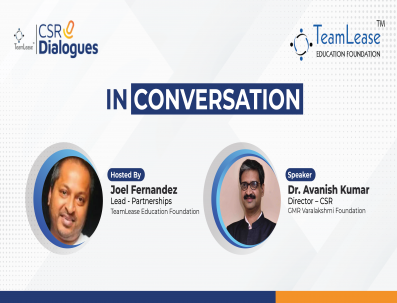
Bringing women back into the mainstream workforce
Welcome to CSR Dialogues from TeamLease Education Foundation, where industry leaders come together to discuss relevant progressive topics around the social development sector, including Corporate Social Responsibility. For a recent session, we invited Dr Avanish Kumar, Director – CSR, GMR Varalakshmi Foundation, for an interactive one-on-one conversation with Mr Joel Fernandez, Lead - Partnerships, TeamLease Education Foundation.
Here is the summary of the conversation.
There are historical and traditional reasons why gender inequality has been all over the world, especially in India. And while it has been slowly eroding, we still have a long way to go. Women and girls have been stigmatised as homely bodies. They are restricted from getting an education or getting a professional degree, as it is believed that all their basic duty is to do household chores. In villages, the condition is even worse. Even if a girl child is enrolled in schools, they are only sent to public schools while boys would be sent to private schools. The differentiation is quite prominent. Breaking this kind of mindset will still take some time.
Key differentiators to change the condition of women, which will eventually improve women's literacy rate
- A huge cultural change and change in the mindset of the people is required.
- Big campaigns like Beti Bachao Beti Padhao should be promoted, as they are really impactful on a larger scale.
- Important stakeholders like Anganwadi workers should be involved in the implementation of these campaigns. For example, an Anganwadi worker looks after all the pregnant women in the area from the delivery of the child to getting all sorts of vaccination.
- Many educational institutions are bringing gender inclusivity with their special programs. Since engineering is considered to be a male dominant field, IIT institution introduced 800 more seats just to get more girl students.
- Several measures have been suggested in the NEP for the gender inclusion fund. There are resources to create or build special programs for girls' education through scholarships or incentivisation.
Role of CSR in bridging the gap literacy gap
Skilling is a major vertical for GMR Varalakshmi Foundation. They have a good ratio between boys and girls in skilling programs. They also try to bring some innovative courses specially designed to have more girl participation. GMR foundation also tries to promote as many non-traditional job roles for women as possible. Recently, in Gujarat, they started a skill development program for E-auto drivers only for women. Relocation is another major issue for getting girls into the workplace. Even if they are equally skilled as their male counterparts, they are hesitant to move to metropolitan areas to work. Enabling technology to bring more jobs virtually can help make the situation better.
Bringing women back into the mainstream workforce
India is a developing country and yet women participating in the labour force slipped from 33 to 27 in the last year. There are several reasons women drop out of the workforce either after getting married or having kids. But corporate India has to make several effective measures to improve these receding numbers and bring back women workforce even after a gap
Companies should provide all kinds of support for working women. Flexible working hours, benefits of working from home, maternity leaves, and allowances, should be factored in during that period. Also for the husbands, giving paternity leave is a progressive step because the father is responsible to take care of the child as much as a mother is.
Mr Joel Fernandez, Lead - Partnerships, TeamLease Education Foundation concluded the discussion by saying, ‘women can make a huge change in the community if given the right kind of support and opportunities. Because they are better leaders than most of us.’





